Retro Reflective Materials Market Size
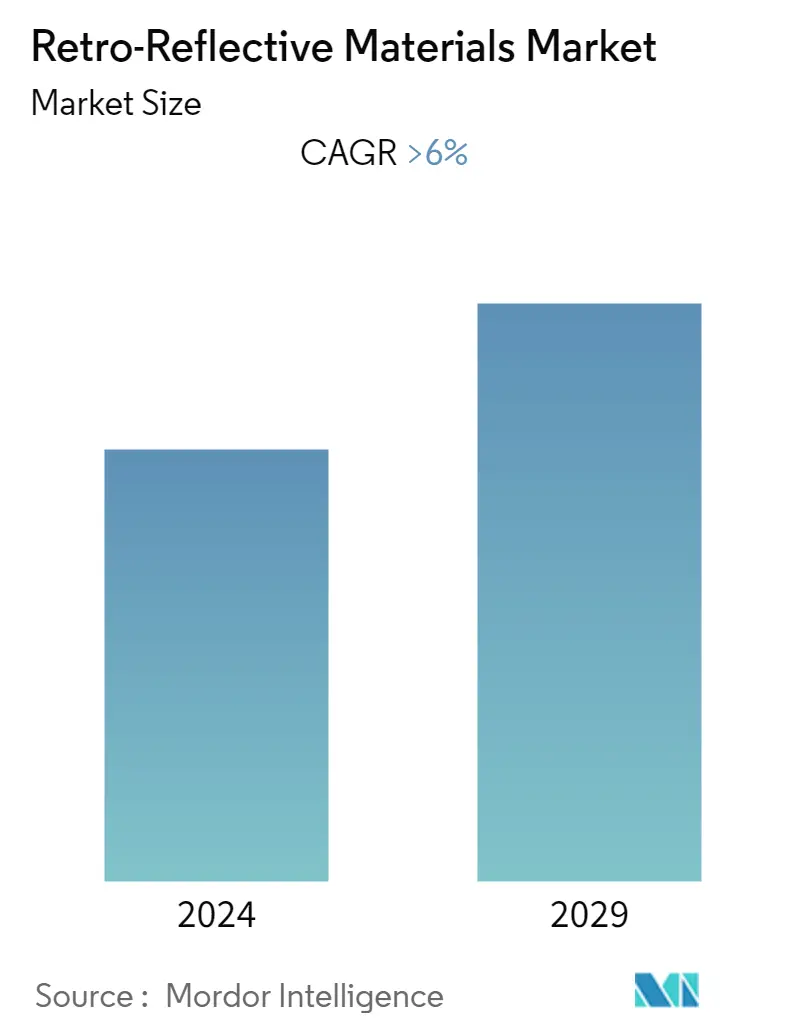
| Study Period | 2019 - 2029 |
| Base Year For Estimation | 2023 |
| CAGR | 6.00 % |
| Fastest Growing Market | Asia Pacific |
| Largest Market | Europe |
| Market Concentration | Low |
Major Players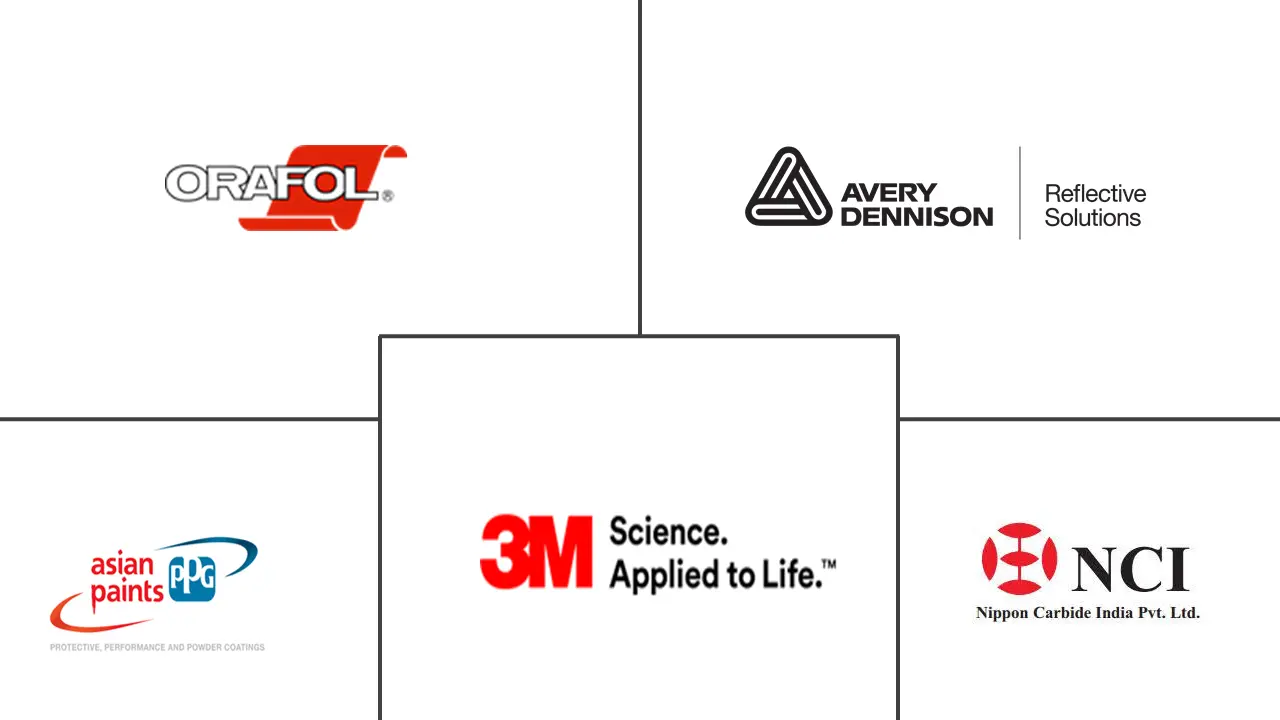
*Disclaimer: Major Players sorted in no particular order |
Retro Reflective Materials Market Analysis
The market for retro-reflective materials is expected to grow at a CAGR of more than 6% globally during the forecast period (2022-2027).
The Covid pandemic has affected the retro-reflective materials market negatively majorly due to the disruptions in work and lockdown disruptions. End-user industries such as Automotive observed a decline in both production and sales, whereas Industrial end-user industries had to face repeated shutdowns with each passing wave of pandemic cases.
- Increasing applications of road safety products and the growing demand from the automotive industry in developing countries are driving the market growth.
- The outbreak of COVID-19 is expected to hinder the market growth of the retro-reflective materials market during the forecast period (2022-2027).
- Asia Pacific region is expected to dominate the global market and is estimated to witness highest growth rate in the forecast period.
Retro Reflective Materials Market Trends
This section covers the major market trends shaping the Retro Reflective Materials Market according to our research experts:
Increasing Demand from Automotive and Construction Segments
- Retro-Reflective Materials are the materials that reflect light to its source. This retro-reflectors are being used for safety purposes in different end-user industries such as in construction, mining, infrastructure, textile, and automobile industries.
- Retro-Reflective Materials use ceramic beads, glass beads, and microprismatic technologies in various applications.
- At construction sites, these reflectors are used in signboards, apparel for personnel, and vehicles that are being used in the construction sites. Windows, architectural glasses are the application major segments of the construction industry.
- Also, growing traffic safety systems is one of the prominent factors for the need for retroreflective technologies. These materials can be used as traffic signboards, markings, and temporary traffic control applications.
- In automobiles, these tapes are being used on the side, rear, and front side of vehicles for clear visibility to other drivers or pedestrians at night to avoid collisions.
- The impact of the COVID-19 shutdowns is expected to decrease the usage and demand for retro-reflective materials from different sectors in the near future.
- However, the growth potential automotive sector in developing countries and the growing construction and road safety activities are expected to drive the market for retro-reflective materials through the years to come.
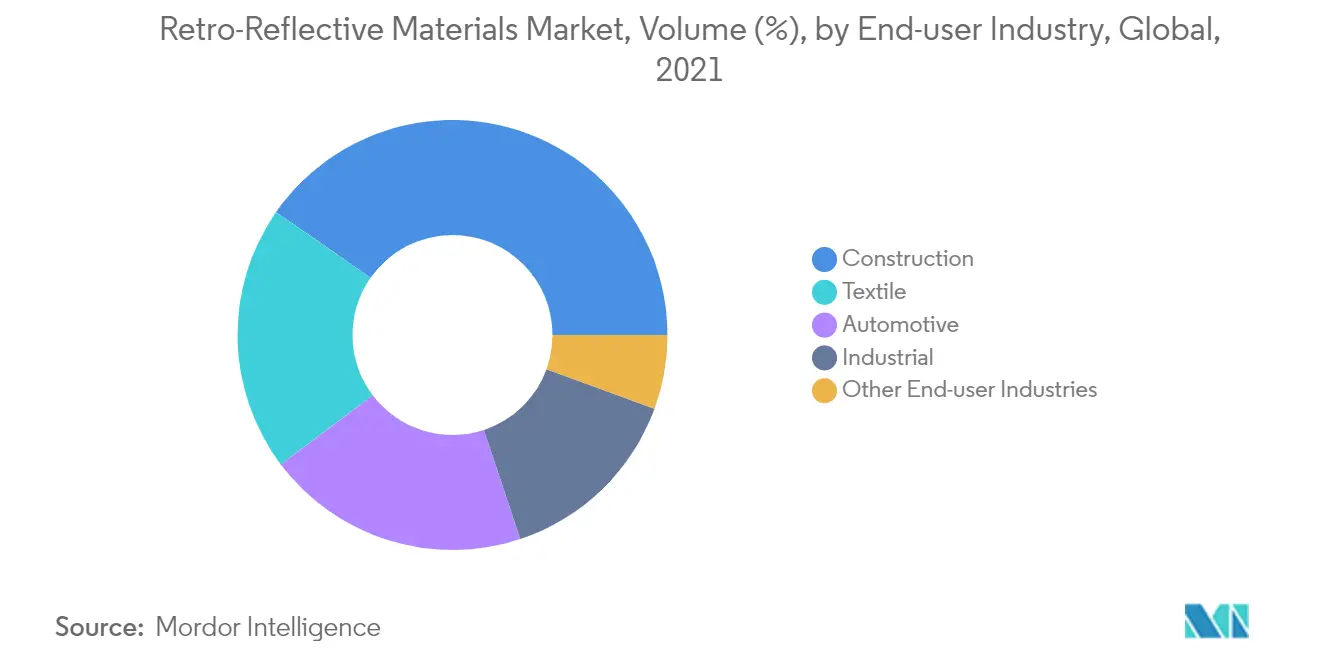
Asia Pacific Region to Dominate the Market
- Asia-Pacific is expected to dominate the global market owing to the highly developed automotive sector in China, India, and Japan, coupled with the development of textile and construction industries in the region in recent years.
- Retro-Reflective Materials are also being majorly used in textiles that can be used for various purposes. Micro prismatic technology incorporates retro-reflective microscopic prisms formed on a polymeric film to create a bright reflective appearance on garments and accessories.
- The applications include sportswear, shirts, shoes, vests, fashion, jackets, belts, armbands, signs, safety vests, backpacks, badges, belts, and raincoats.
- According to research by the Department for Transport, road casualty statistics show that 40 percent of collisions occur in the hours of darkness. Due to such factors, the demand for retro-reflective materials for road safety and signs has been growing significantly.
- Rapid industrialization, mining industries in Asia-Pacific have witnessed decent growth in recent years. The safety activities around these industries increase the demand for retro-reflective materials.
- The outbreak of COVID-19 has affected the economic growth of all the countries at present, with almost all the construction and transport sectors been stopped due to lockdown for a brief period.
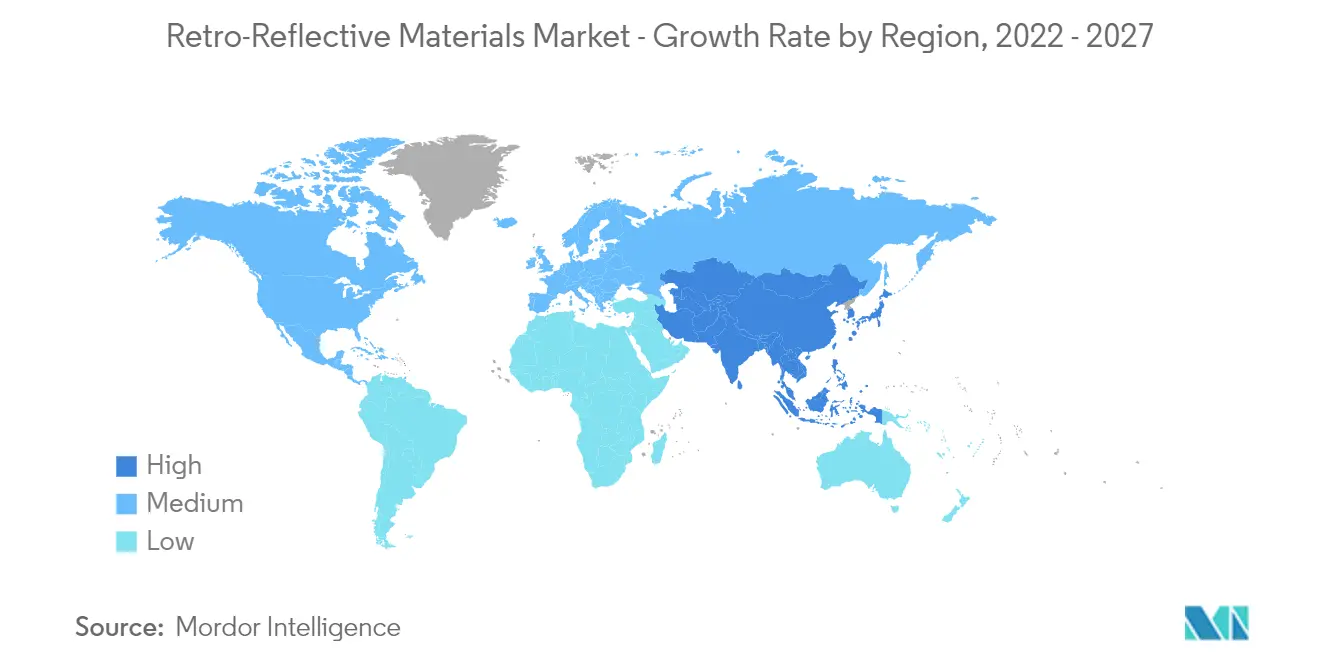
Retro Reflective Materials Industry Overview
The retro-reflective materials market is fragmented in nature with many players competing in the market. Some of the major companies (in no particular order) are 3M Company, ORAFOL Europe GmbH, Avery Dennison Corporation, Nippon Carbide Industries Co., Inc, and Asian Paints PPG, among others.
Retro Reflective Materials Market Leaders
-
3M Company
-
ORAFOL Europe GmbH
-
Avery Dennison Corporation
-
Nippon Carbide Industries Co., Inc
-
Asian Paints PPG
*Disclaimer: Major Players sorted in no particular order
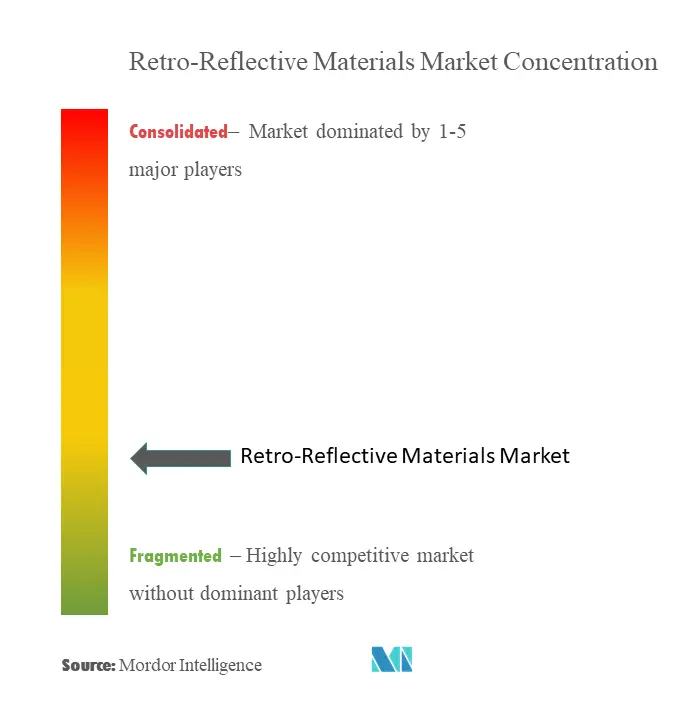
Retro Reflective Materials Market News
There are no new recent developments pertaining to the market studied.
Retro Reflective Materials Market Report - Table of Contents
1. INTRODUCTION
- 1.1 Study Assumptions
- 1.2 Scope of the Study
2. RESEARCH METHODOLOGY
3. EXECUTIVE SUMMARY
4. MARKET DYNAMICS
-
4.1 Drivers
- 4.1.1 Increasing Applications for Road Saftey Products
- 4.1.2 Growing Demand from the Automobile Sector
- 4.2 Restraints
- 4.3 Industry Value Chain Analysis
-
4.4 Porters Five Forces Analysis
- 4.4.1 Threat of New Entrants
- 4.4.2 Bargaining Power of Buyers
- 4.4.3 Bargaining Power of Suppliers
- 4.4.4 Threat of Substitute Products
- 4.4.5 Degree of Competition
5. MARKET SEGMENTATION
-
5.1 Technology
- 5.1.1 Ceramic Beads
- 5.1.2 Glass Beads
- 5.1.3 Microprismatic
-
5.2 Product Type
- 5.2.1 Films, Sheets and Tapes
- 5.2.2 Paints and Inks
- 5.2.3 Other Types
-
5.3 End-user Industry
- 5.3.1 Automotive
- 5.3.2 Industrial
- 5.3.3 Construction
- 5.3.4 Textile
- 5.3.5 Other End-user Industries
-
5.4 Geography
- 5.4.1 Asia-Pacific
- 5.4.1.1 China
- 5.4.1.2 India
- 5.4.1.3 Japan
- 5.4.1.4 South Korea
- 5.4.1.5 Rest of Asia-Pacific
- 5.4.2 North America
- 5.4.2.1 United States
- 5.4.2.2 Canada
- 5.4.2.3 Mexico
- 5.4.3 Europe
- 5.4.3.1 Germany
- 5.4.3.2 United Kingdom
- 5.4.3.3 France
- 5.4.3.4 Italy
- 5.4.3.5 Rest of Europe
- 5.4.4 South America
- 5.4.4.1 Brazil
- 5.4.4.2 Argentina
- 5.4.4.3 Rest of South America
- 5.4.5 Middle-East and Africa
- 5.4.5.1 Saudi Arabia
- 5.4.5.2 South Africa
- 5.4.5.3 Rest of Middle-East and Africa
6. COMPETITIVE LANDSCAPE
- 6.1 Mergers and Acquisitions, Joint Ventures, Collaborations, and Agreements
- 6.2 Market Share (%)**/Ranking Analysis
- 6.3 Strategies Adopted by Leading Players
-
6.4 Company Profiles
- 6.4.1 3M Company
- 6.4.2 Asian Paints PPG
- 6.4.3 Avery Dennison Corporation
- 6.4.4 Changzhou Hua R Sheng Reflective Material Co., Ltd
- 6.4.5 Coats Group Plc
- 6.4.6 Nippon Carbide Industries Co., Inc
- 6.4.7 ORAFOL Europe GmbH
- 6.4.8 Paiho Group
- 6.4.9 REFLOMAX Co., Ltd
- 6.4.10 Unitika Sparklite Ltd
- *List Not Exhaustive
7. MARKET OPPORTUNITIES AND FUTURE TRENDS
** Subject To AvailablityRetro Reflective Materials Industry Segmentation
Retroreflective materials have the ability to reflect incident energy back towards its source regardless of the direction of incidence, hence they are perceived as an innovative solution to reduce the energy required for cooling and to improve urban microclimates. The Retro-Reflective Materials Market report segmentation includes Technology Type, Product Type, End-user Industry, and Geography. By Technology Type the market is segmented in Ceramic Beads, Glass Beads, and Microprismatic, segmentation in Product Type includes Films, Sheets and Tapes, Paints and Inks, and Other Types, in End-user Industry, the segmentation includes Automotive, Industrial, Construction, Textile, and Other End-user Industries and in terms of Geography into Asia-Pacific, North America, Europe, South America, and Middle-East and Africa. The report offers market size and forecasts for retro-reflective materials in terms of revenue (USD million) for all the above segments.
| Technology | Ceramic Beads | |
| Glass Beads | ||
| Microprismatic | ||
| Product Type | Films, Sheets and Tapes | |
| Paints and Inks | ||
| Other Types | ||
| End-user Industry | Automotive | |
| Industrial | ||
| Construction | ||
| Textile | ||
| Other End-user Industries | ||
| Geography | Asia-Pacific | China |
| India | ||
| Japan | ||
| South Korea | ||
| Rest of Asia-Pacific | ||
| Geography | North America | United States |
| Canada | ||
| Mexico | ||
| Geography | Europe | Germany |
| United Kingdom | ||
| France | ||
| Italy | ||
| Rest of Europe | ||
| Geography | South America | Brazil |
| Argentina | ||
| Rest of South America | ||
| Geography | Middle-East and Africa | Saudi Arabia |
| South Africa | ||
| Rest of Middle-East and Africa |
Retro Reflective Materials Market Research FAQs
What is the current Retro-Reflective Materials Market size?
The Retro-Reflective Materials Market is projected to register a CAGR of greater than 6% during the forecast period (2024-2029)
Who are the key players in Retro-Reflective Materials Market?
3M Company , ORAFOL Europe GmbH , Avery Dennison Corporation , Nippon Carbide Industries Co., Inc and Asian Paints PPG are the major companies operating in the Retro-Reflective Materials Market.
Which is the fastest growing region in Retro-Reflective Materials Market?
Asia Pacific is estimated to grow at the highest CAGR over the forecast period (2024-2029).
Which region has the biggest share in Retro-Reflective Materials Market?
In 2024, the Europe accounts for the largest market share in Retro-Reflective Materials Market.
What years does this Retro-Reflective Materials Market cover?
The report covers the Retro-Reflective Materials Market historical market size for years: 2019, 2020, 2021, 2022 and 2023. The report also forecasts the Retro-Reflective Materials Market size for years: 2024, 2025, 2026, 2027, 2028 and 2029.
Retro-Reflective Materials Industry Report
The market for retro-reflective materials is segmented by technology type, product type, end-user industry, and geography. The technology types include ceramic beads, glass beads, and microprismatic. Product types are categorized into films, sheets and tapes, paints and inks, and other types. The end-user industries encompass automotive, industrial, construction, textile, and other industries. Geographically, the market spans Asia-Pacific, North America, Europe, South America, and the Middle-East and Africa.
The industry report provides a comprehensive market analysis, including industry information and industry statistics. The market segmentation is detailed by technology type, product type, end-user industry, and geography. The market size and industry size are forecasted, offering insights into market growth and industry growth. The market forecast and industry outlook predict future trends and market predictions.
The report includes market data and industry research, highlighting market trends and industry trends. It provides an industry overview and market overview, detailing market value and market review. The market leaders and industry leaders are identified, offering insights into market dynamics and industry sales.
The report example and report PDF provide a detailed market report and industry report, offering a comprehensive market research and industry analysis. The market outlook and industry outlook are discussed, providing a thorough industry review and market review. The research companies involved in the market research are also mentioned.
In summary, the report offers a detailed analysis of the retro-reflective materials market, including market segmentation, market size, market growth, market forecast, and market trends. The industry analysis includes industry information, industry statistics, industry size, industry growth, and industry trends. The report provides valuable insights into the market outlook and industry outlook, offering a comprehensive industry review and market review.



